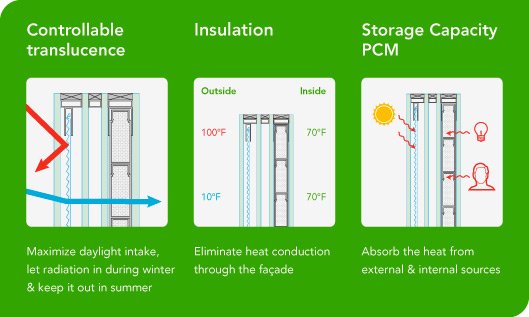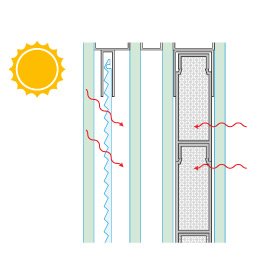The above video explains what makes GlassX so revolutionary. But for you readers out there, here’s a more in depth discussion.
PCM and Thermal Mass
Buildings with large amounts of glazing face a huge problem come summer time: overheating. Unlike old buildings which had thick, solid walls, modern buildings with large amounts of glazing lack the thermal mass needed to stabilize large oscillations in temperature. These wild variations in temperature greatly affect comfort in the space, which creates the need for costly, oversized air-conditioning systems. This, of course, greatly increases energy demand.
The GlassX solution? Add “thermal mass” to the glazed areas of buildings, allowing them to transmit visible light while absorbing infrared radiation.
At the core of GlassX is a Phase Change Material (PCM), which provides a thermal mass equivalent to that of 16” of concrete. This PCM is made of Calciumchloridehexahydrate (CaCl2 6H2O), a nontoxic salt, whose melting point is precisely at room temperature. In summer, when the building interior rises above this temperature, the PCM melts and absorbs the thermal energy that would otherwise lead to overheating. The PCM absorb internals heat loads by convection, but also absorbs external solar energy input.
After 8 hours of direct solar radiation, the PCM will likely be entirely molten. However, by this time, the external temperature will have started to decrease below the melting point of the PCM. It will start to recrystallize in the cooler night air. The next morning, the PCM will have solidified completely, and the cycle will begin again. This makes GlassX a passive system.
This thermal storage has two effects; shifting peak energy demand later into the night when temperatures typically fall off, and reducing average interior room temperatures by 5-9°C, drastically reducing the need for air conditioning. In winter, GlassX maximizes solar gains, charging up the PCM core, allowing it to radiate throughout the night as it solidifies.
[show the phase changing images]
PRISM technology
Façades need a shading device that can allow solar gains in winter, but block direct solar radiation in summer. GlassX achieves this by way of a transparent prism. This prism, which is located in the space between the outer glass panes, allows light from the low winter sun to pass, almost unimpeded. When the sun is at a higher angle, between April and September, the prism reflects direct solar radiation. Only the diffuse, low-energy component of the solar radiation – visible light – passes through to the interior.
In short, GlassX’s Prism reflects summer solar radiation (>40°) but allows winter solar radiation to pass (<35°), creating a variable Solar Heat Gain Coefficient SHGC.
Insulating Properties
Completing the all-in-one passive solar design is quadruple insulating glass unit with inert gas and low-e coatings, which provides insulation equivalent to that of an R12 wall. U-value of 0.08 Btu/F-ft²-hr. This helps keep warm air inside during winter, and cold air inside during summer.
Principles of GlassX
Combining the translucence of glass with the thermal properties of a solid wall.




